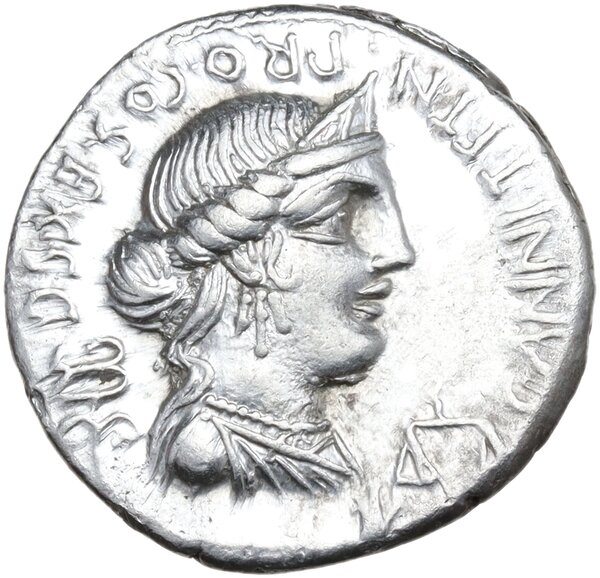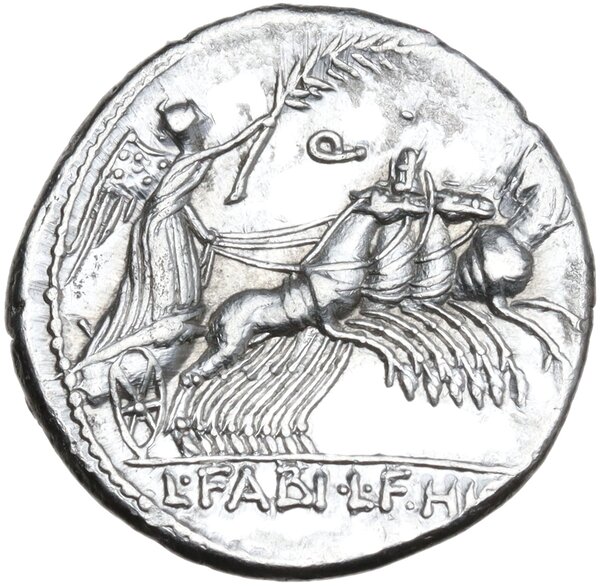The only Perenna's Portrait from Ancient World.


拍品号 436:
C. Annius with L. Fabius L. f. Hispaniensis. AR Denarius, 82-81 BC. Obv. C. ANNI. T. F. T. N. PRO. COS. EX. S.C. Diademed and draped bust of Anna Perenna right; behind, caduceus; below chin, scales; below bust, uncertain symbol. Rev. Victoria in galloping quadriga right; above, Q; in exergue, L. FABI. L. F. HISP. Cr. 366/1a; B. 2. 3.92 g. 18.00 mm. An outstanding example, well centred on a broad flan and complete. Brilliant, superb and lightly toned. Very rare as such. Good EF. Anna Perenna was a Roman divinity, the legends about whom are related by Ovid and Virgil. According to them she was a daughter of Belus and sister of Dido. After the death of the latter, she fled front Carthage to Italy, where she was kindly received by Aeneas. Here her jealousy of Lavinia was roused, and being warned in a dream by the spirit of Dido, she fled and threw herself into the river Numicius. Henceforth she was worshiped as the nymph of that river under the name of Perenna, for previously her name had simply been Anna.
A second story related by Ovid states, that when the plebs had seceded to the mons sacer and were in want of food, there came from the neighboring Bovillae an aged woman of the name of Anna, who distributed cakes among the hungry multitude, and after their return to the city the grateful people built a temple to her. A third story, likewise related by Ovid, tells us that, when Mars was in love with Minerva, he applied to the aged Anna to lend him her assistance. She appeared before him herself in the disguise of Minerva, and when the god took hold of her veil and wanted to kiss her, she laughed him to scorn.
Ovid remarks that Anna Perenna was considered by some as Luna, by others as Themis, and by others again as Io, the daughter of Inachus, or as one of the nymphs who brought up the infant Jove.
Now as Macrobius states, that at her festival, which fell on the 15th of March, and was celebrated by the Romans with great joy and merriment, the people prayed ut annare perennareque commode liceat, it seems clear that Anna Perenna was originally an Italian divinity, who was regarded as the giver of life, health, and plenty, as the goddess whose powers were most manifest at the return of spring when her festival was celebrated. The identification of this goddess with Anna, the sister of Dido, is undoubtedly of late origin. (Encyclopedia Mythica).
A second story related by Ovid states, that when the plebs had seceded to the mons sacer and were in want of food, there came from the neighboring Bovillae an aged woman of the name of Anna, who distributed cakes among the hungry multitude, and after their return to the city the grateful people built a temple to her. A third story, likewise related by Ovid, tells us that, when Mars was in love with Minerva, he applied to the aged Anna to lend him her assistance. She appeared before him herself in the disguise of Minerva, and when the god took hold of her veil and wanted to kiss her, she laughed him to scorn.
Ovid remarks that Anna Perenna was considered by some as Luna, by others as Themis, and by others again as Io, the daughter of Inachus, or as one of the nymphs who brought up the infant Jove.
Now as Macrobius states, that at her festival, which fell on the 15th of March, and was celebrated by the Romans with great joy and merriment, the people prayed ut annare perennareque commode liceat, it seems clear that Anna Perenna was originally an Italian divinity, who was regarded as the giver of life, health, and plenty, as the goddess whose powers were most manifest at the return of spring when her festival was celebrated. The identification of this goddess with Anna, the sister of Dido, is undoubtedly of late origin. (Encyclopedia Mythica).
起拍价 € 250
当前出价 € 250
出价数: 1
无可供出售
当前出价 € 250
出价数: 1
无可供出售





